

Alborz Fallah
Australia’s road toll climbs despite record speeding fines
3 Hours Ago
The versatile Crafter ‘toolbox’ offers a likeable and user-friendly load-lugging cab-chassis that can be tailor-fit to your needs.
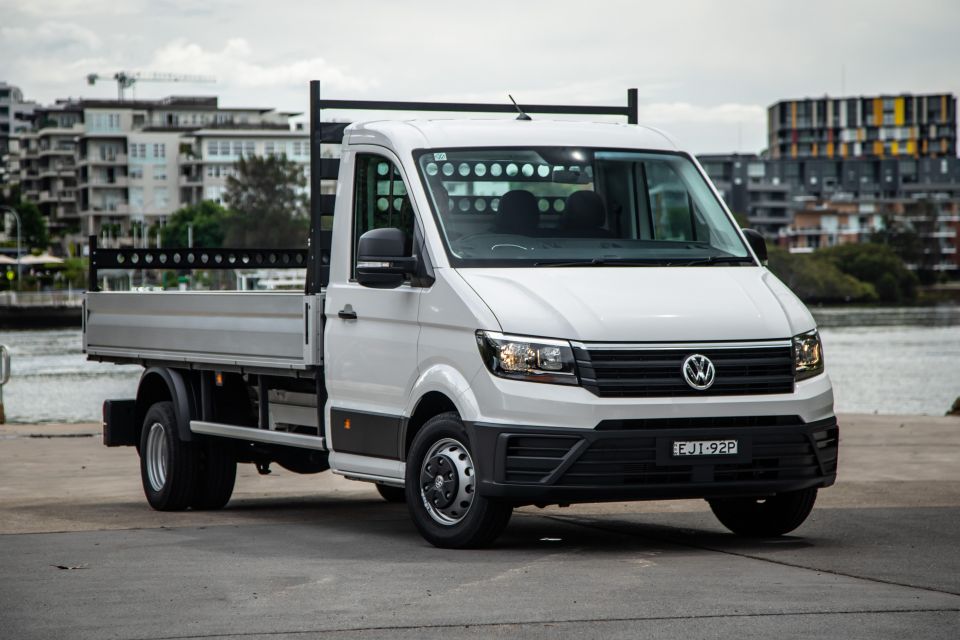


Journalist
New from
$48,890
excl. on-roads

Journalist
New from
$48,890
excl. on-roads


Journalist
New from
$48,890
excl. on-roads

Journalist
New from
$48,890
excl. on-roads
Quickly see how this car stacks up against its competition. Select any benchmark to see more details.
Where expert car reviews meet expert car buying – CarExpert gives you trusted advice, personalised service and real savings on your next new car.
“Crafted by you” is the Volkswagen Crafter van range’s catchphrase buyers can take literally, short of donning overalls and tools and constructing one right on the VW factory floor.
It’s less a range of van-based commercials and more a toolbox of chassis, body, powertrain, payload and towing options to consolidate into a perfect-fit vehicle to suit your whims. And that’s before you dip onto what its maker claims are well over 100 optional features.
Crafter brings vans, minibuses and cab chassis (as tested here); dual- or single-cab (ditto) bodies; front-, all- or rear-wheel-drive (ditto); and a choice of low- or high-power (ditto) diesel engines…and sorting through that menu won’t get you past the first page of the catalogue…
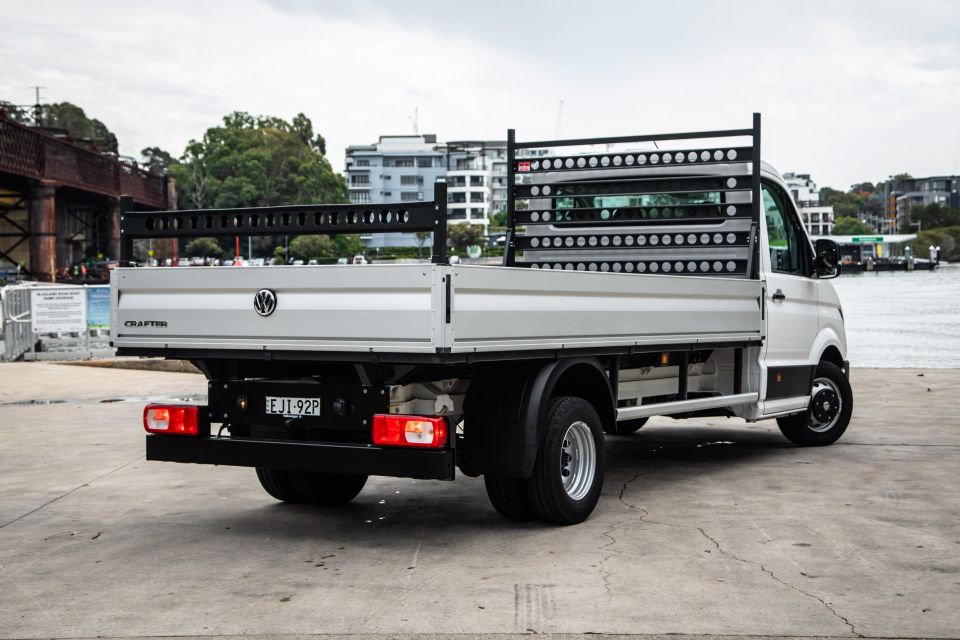
Our test subject here is – deep breath – the Volkswagen Crafter 50 LWD (long-wheelbase) Cab-Chassis TDI410 Auto RWD (rear-wheel-drive) with Factory Tray. The ‘50’ bit is important here as it refers to the 4490kg GVM rating, available in all single- and dual-cab variations, meaning you don’t need a truck licence to drive it.
That said, you can have it’s two cab and three chassis length choices – medium, long and ‘long with overhang’ – in a tougher-lugging ‘55’ spec boasting a 5500kg GVM suitable for truck drivers.
Essentially, our subject represents a light truck of formidable lugging and towing capabilities in an automatic-equipped, car-licence-friendly form anyone could drive. So a dedicated work truck any employee could steer or any family member could pinch (in a pinch) as a surrogate runabout if need be.
Is it easy enough to use for all and sundry purposes? Let’s find out.
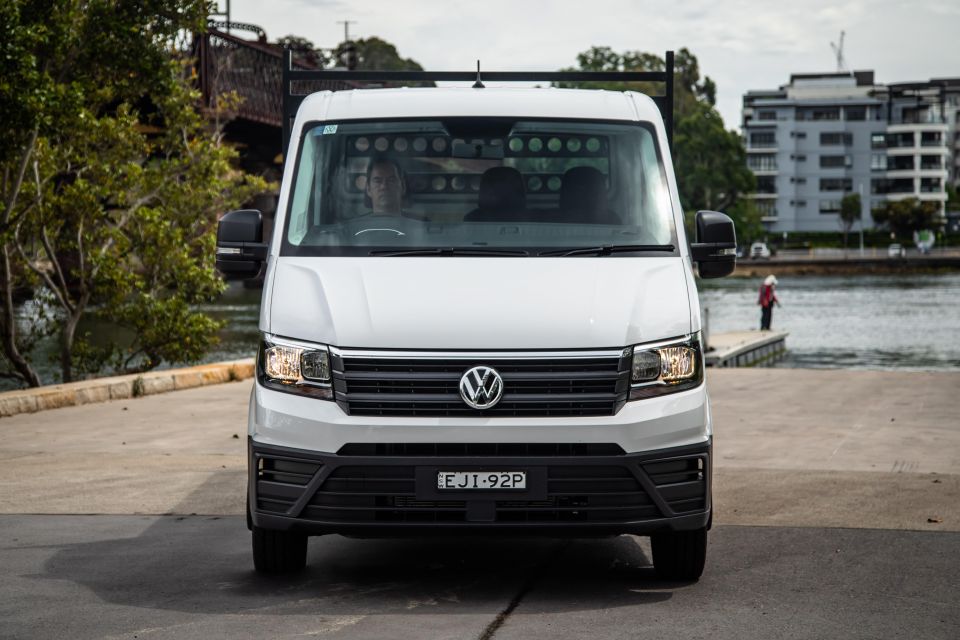
Our 50 TDI410 auto LWB RWD with tray clocks in at $64,680 before on-roads or around $70,000 on road.
That said, the Cab Chassis range kicks off at just under $50,000 and climbs to around $70,000. As a very rough guide, moving up and down in two engine specs, two cab styles, three chassis lengths, and three drivetrain type moves pricing around $2500-$5000 per category.
Essentially, the step up from the base 35 (3.55t GVM) to 50 (4.49t GVM) trim upgrades from a single- to a dual-rear rim and tyre configuration.
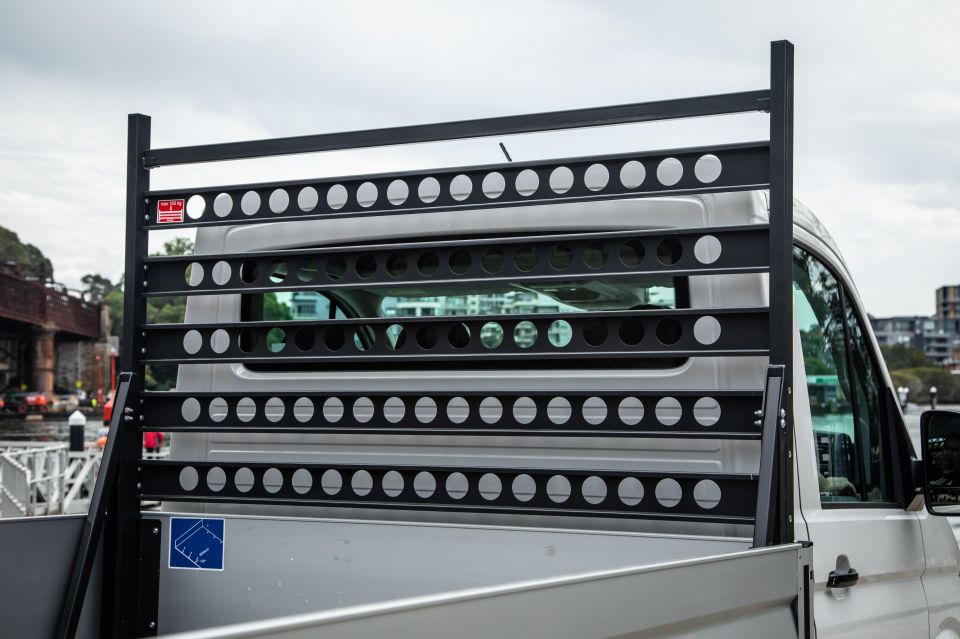
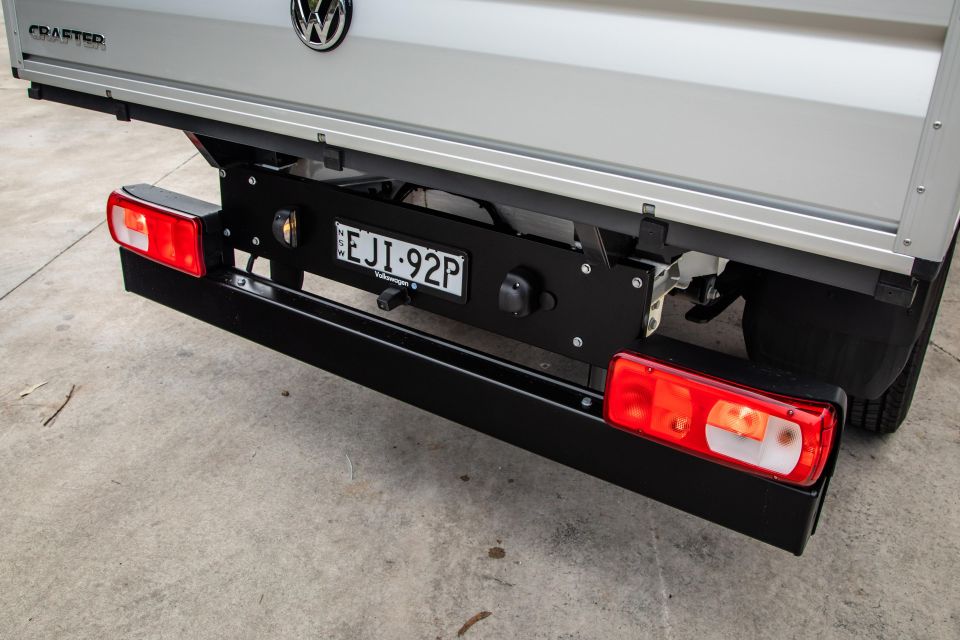
In cab-chassis form, the Crafter offers a host of options including a security system ($890), LED headlights ($1690), auto headlights and wipers ($395), heavy-duty spring/dampers ($290) and sway bars ($190) separately or in combination ($490), a variety of seating changes as well as other spec tweaks, some of which are at no extra cost (grey bumpers, two-seater conversion, et al).
Paint wise, a choice of white of four solid colours are no cost, with two metallics and one pearlescent finish wanting for a $2310 premium. Wheels can had in standard silver or optional black finish.
Our tester adds heavy-duty suspension ($490), a ladder-holder with bulkhead ($1305) and acoustic reversing warning ($450), though does fit an aftermarket camera system. Minus the camera, the as-tested pricing here is $66,625 before on roads.
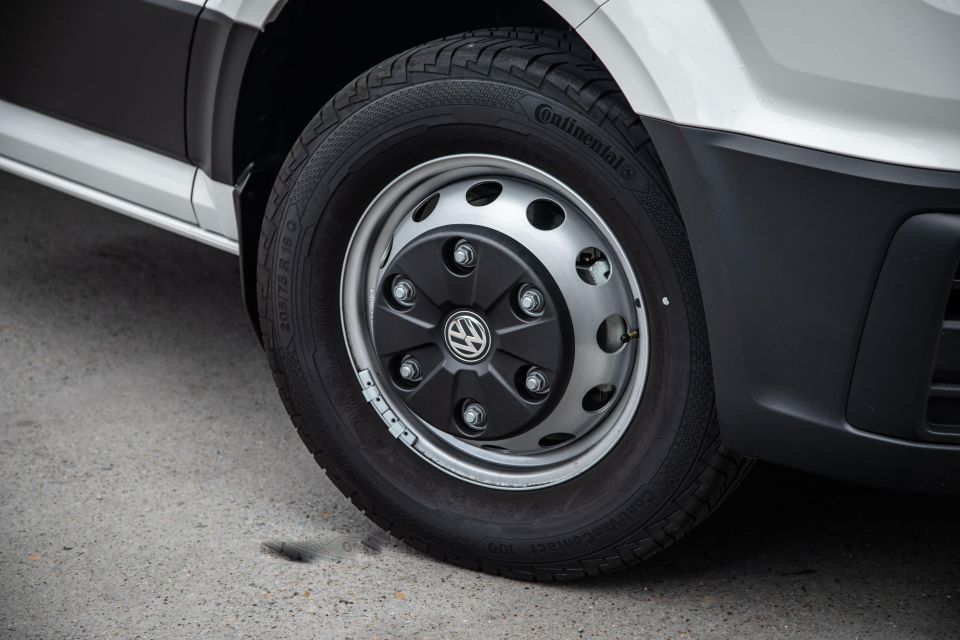
Buy your new car without the stress. It's fast, simple and completely free.

Great service from Travis and team, second time I have used this business would not hesitate to recommend them to anyone
Craig C.
Purchased a Ford Ranger in Sunshine Coast, QLD
CarExpert helped Craig save $7,224 on his Ford Ranger, now let us save you on your next new car.
Get your BEST priceThe following specs are for a clean-skin single-cab chassis, which can be had with or without the factory tray fitted.
Outside, the Crafter fits auto halogen headlights, 16-inch wheels with dual rears, electric-powered heated mirrors, remote entry and central locking, power windows, an underbody stone guard, a full-sized spare wheel and trailer hitch preparation. There are no parking sensors or reversing camera.
Inside, the cabin fits a choice of two-plus-one seating or dual single seats, a ‘Comfort Seat Plus’ driver’s seat with four-way lumber adjustment, cloth trim, a multifunction wheel, LED reading lights, single-zone air-con, dual-USB ports and dual 12-volt outlets, four cup holders, cruise control and a 6.5-inch touchscreen infotainment system with AM/FM radio, Apple CarPlay and Android Auto smartphone mirroring and Bluetooth phone and audio streaming.
At the business end, the factory allow tray is 8.8m square in LWD form, with 4300mm of length, 2040mm of width and 400mm of height and with a load sill height of 1035mm. Payload capacity is 1948kg though this figure changes depending on buyer selected spec. The design features flush safety latches for the folding sides, a wooden floor and integrated step.
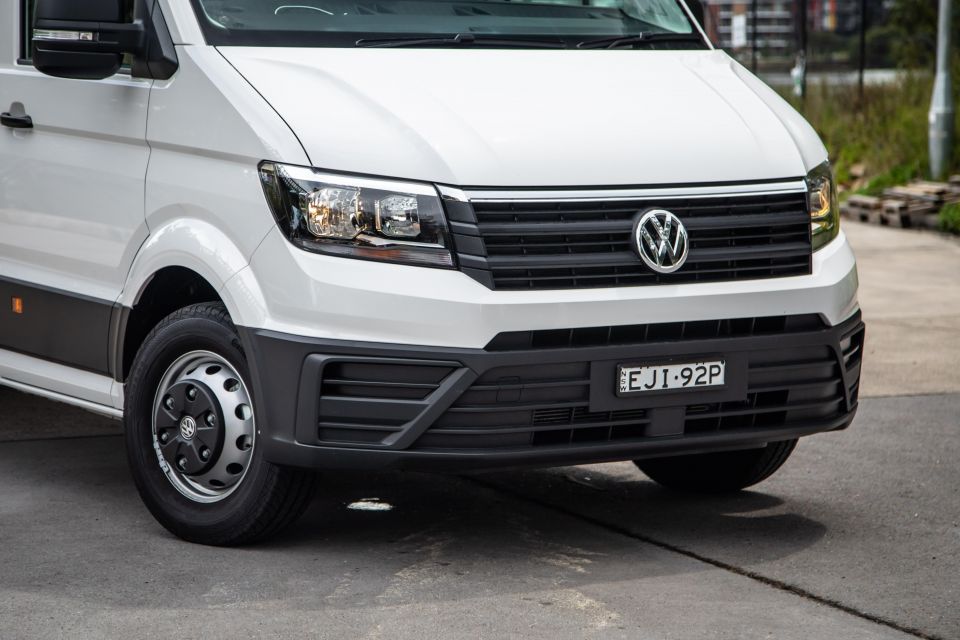
The Crafter range, much like any of its contemporary three-to-five-tonne GVM competition, hasn’t been ANCAP assessed or tested by Euro NCAP.
Our single-cab fits an acceptable amount of safety for its vehicle type. This includes six airbags – driver, side and curtain – as well as low-speed (up to 30km/h) autonomous emergency braking with multi-collision braking assistance, ABS with brake assist, adaptive stability control, hill holding and driver fatigue detection. Some rivals, such as Mercedes-Benz Sprinter, fit further features such as blind spot monitoring as standard.
The lack of a standard-fit reversing camera or parking sensors, particularly given the seven sizeable metres of length, is a sore point though our factory-fitted aftermarket camera, on test, was a godsend.
While adaptive cruise control and lane keeping assistance is available as an option, other features offered in Crafter Van – standard camera and sensors; optional blind-spot monitoring and rear-cross traffic alert – aren’t offered at all on the cab chassis. This is perhaps understandable if you’re fitting a custom or aftermarket tray, less so with a factory tray where spec and dimensions are firmly established.
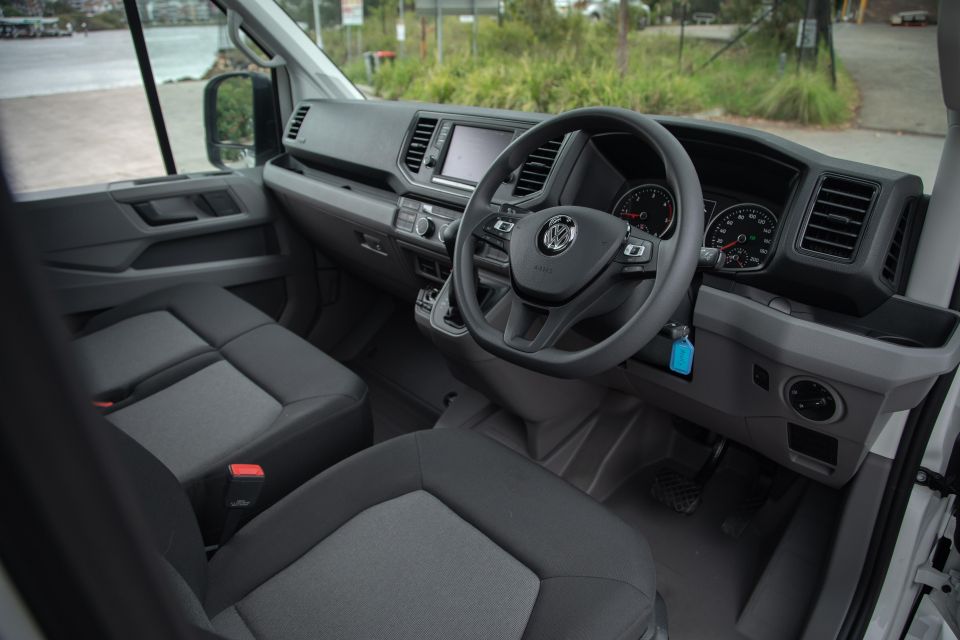
Unsurprisingly, the format and general ambience is not unlike the rival Sprinter cab chassis I reviewed not long ago: a big step up with the aid of a large step and door-mounted grab handles into a spacious and quite welcoming cab with pleasingly massive glass area and an airy ambience.
The sheer width and generous dash-to-seatback adjustment would please the most rotund sumo wrestlers or tallest NBA all-star and the sense of roominess bodes well for the Crafter’s long-haul word-a-day comfort.
Visibility is good, as is the clear vision down both sides of the tray thanks to the big and clear wing mirrors though the rearview mirror is obscured somewhat by the slats in the bulkhead grille.
There’s a dizzying amount of storage: a cubby for every conceivable item almost everywhere you look. There a nice deep lip with the overhead bins to (obviously) stop stuff falling on your head, a large tray strip across the dash fascia for sowing oddment and large dash top folder bins or, if you’re brave, a place to stow your phone or tablet…
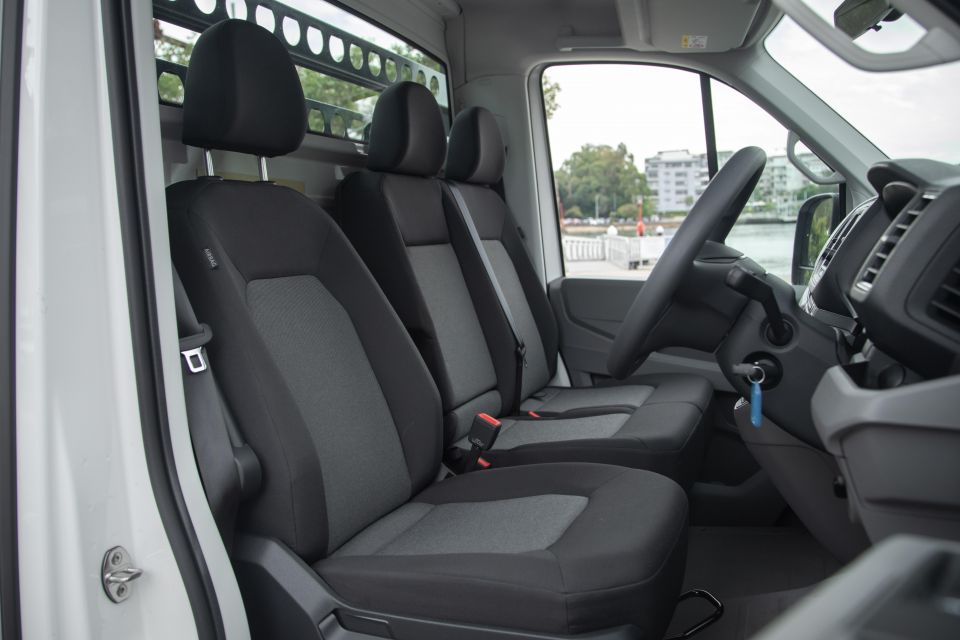
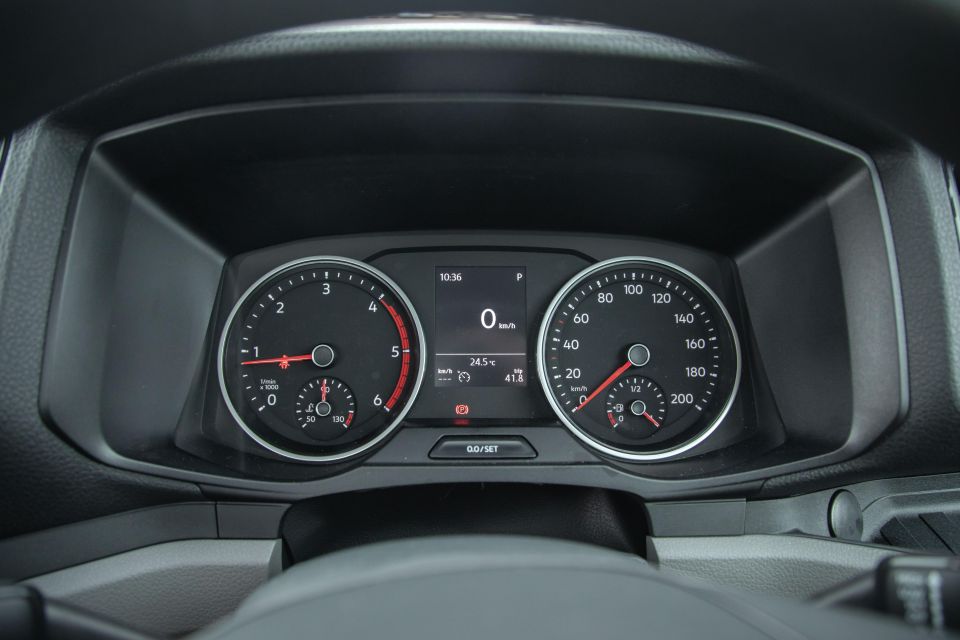
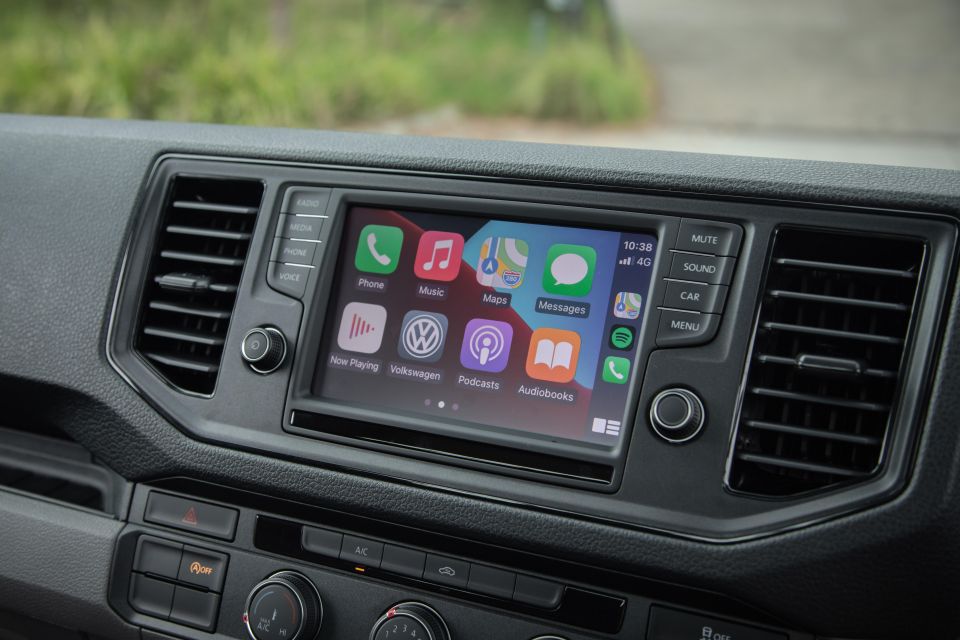
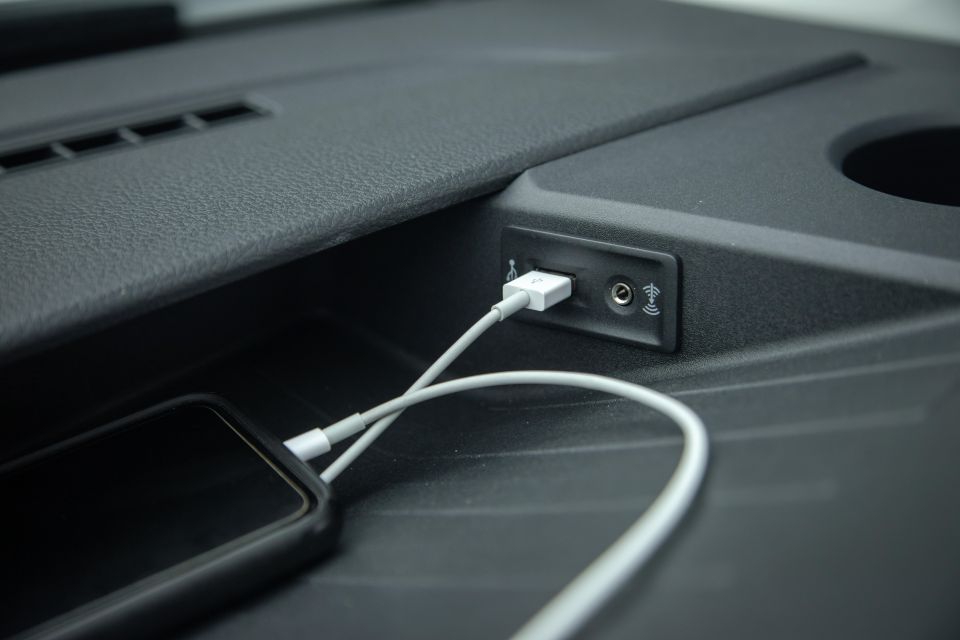
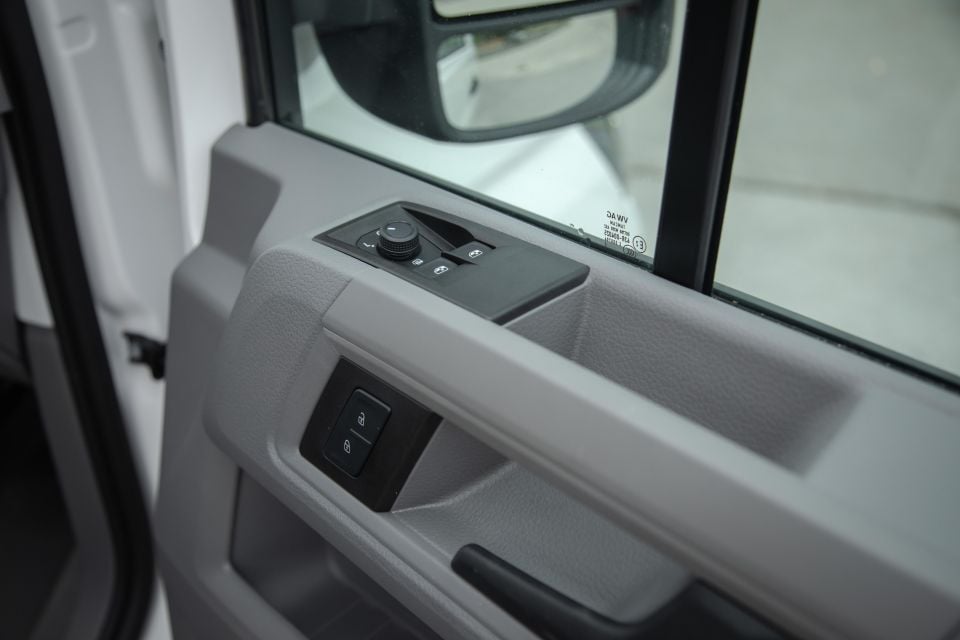
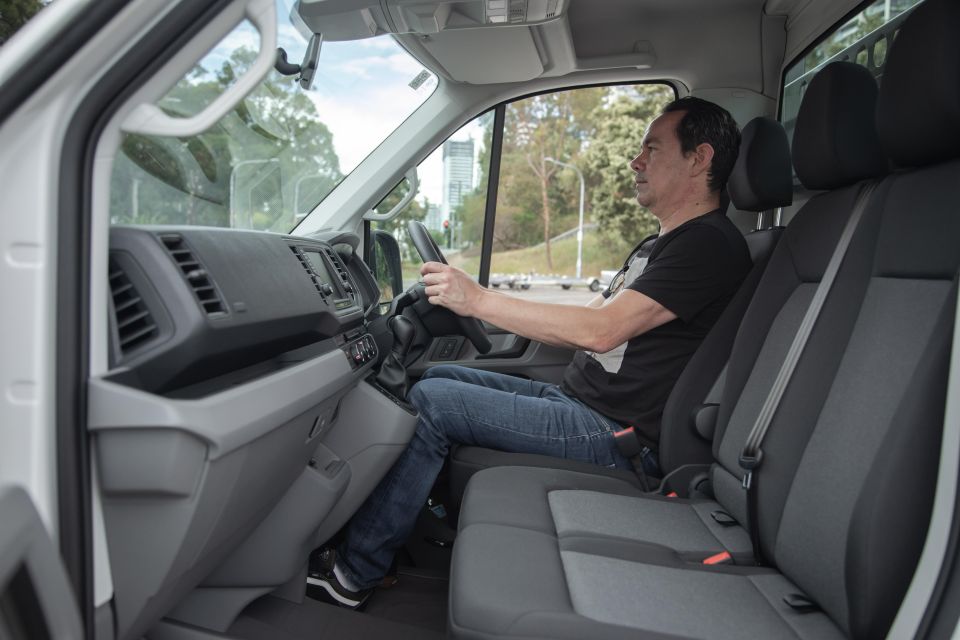
In fact, the driver’s side tray features a USB port and it’s a handy space for your phone if a) you’re not concerned so much about security, b) you’re not concerned about summer heat sink atop the dash and, c) you’re not averse to an argument with authorities when you cop a fine for not having your phone in a fixed cradle even if, technically, you can see the phone at in the bin from the driving position.
There’s a tonne of door storage including facility for bottles in the lower bin but, thankfully, for easier reach there’s a pair of cup holders in the dash commodious enough for 600mm containers. There’s handy under-seat storage, too.
The wheel and pedal controls are located to avoid fatigue and the near-flat floor allows a bit of lounging about with extended seat time. The upper door trims make handy outboard arm rests if you decide not the use the ones either side of the driver’s seat.
Ours is of the regular Comfort Seat Plus design, which offers a surprising amount of height, slide and rake adjustment. Frankly, though, the ride quality of the Crafter around town is terse enough that we’d opt for the optional ErgoActive Suspension design for an extra level of workaday comfort.
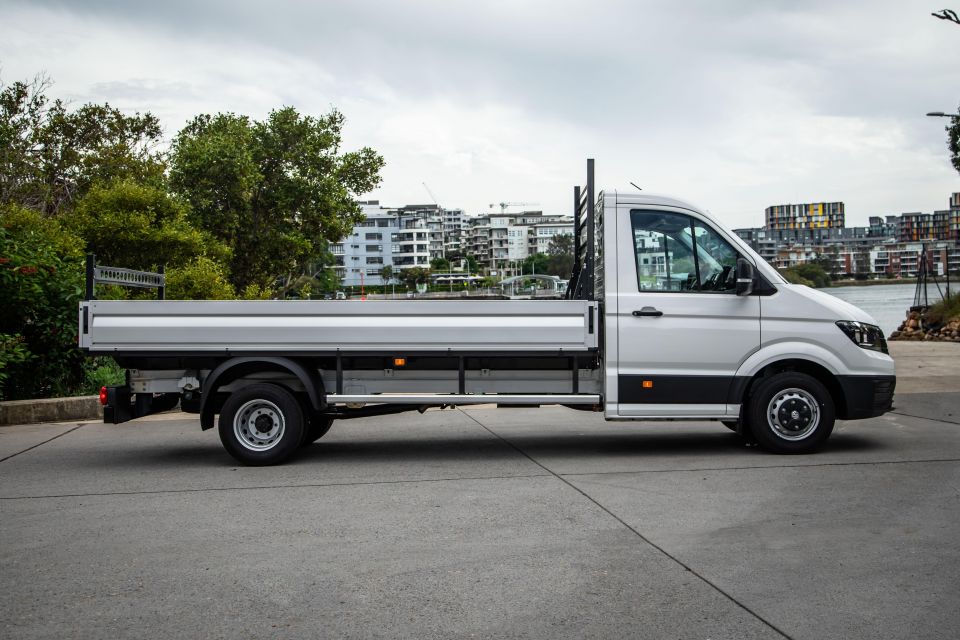
It’s a solid, honest and unpretentious design in a very, erm, workmanlike two-tone grey effect that doesn’t try to climb too upmarket. The analogue instruments are of an old and faithful look, the digital driver’s screen handy and clear enough, and infotainment system is fairly rudimentary. For this sort of money it should really fit proprietary sat-nav and DAB+ as standard if merely for long-haul sanity’s sake.
The bed looks identical to that used by Benz and that’s no bad thing: it has a clever flush-lever design, is rock solid and free of squeaks and rattles. Its interlocking aluminium walls are light yet tough and its grippy wooden floor seems extremely durable and hard wearing.
The bed is nicely designed and built tough, squeak-free and rock solid. The rough screen-printed wooden platform is very grippy and seems quite durable – add the double-walled aluminium sides and plastic hinges and the whole thing is corrosion resistant.
Its 4300mm by 2040mm dimensions is huge, large enough for five Euro pallets if ample for just three of our larger Aussie pallets and, as mentioned above, in this combination there’s almost two tonnes of payload in a machine you can drive on a car licence. It features ten tie-down loops positioned a floor height and they’re easy to access unless you’re really testing the bed’s two-metre width.
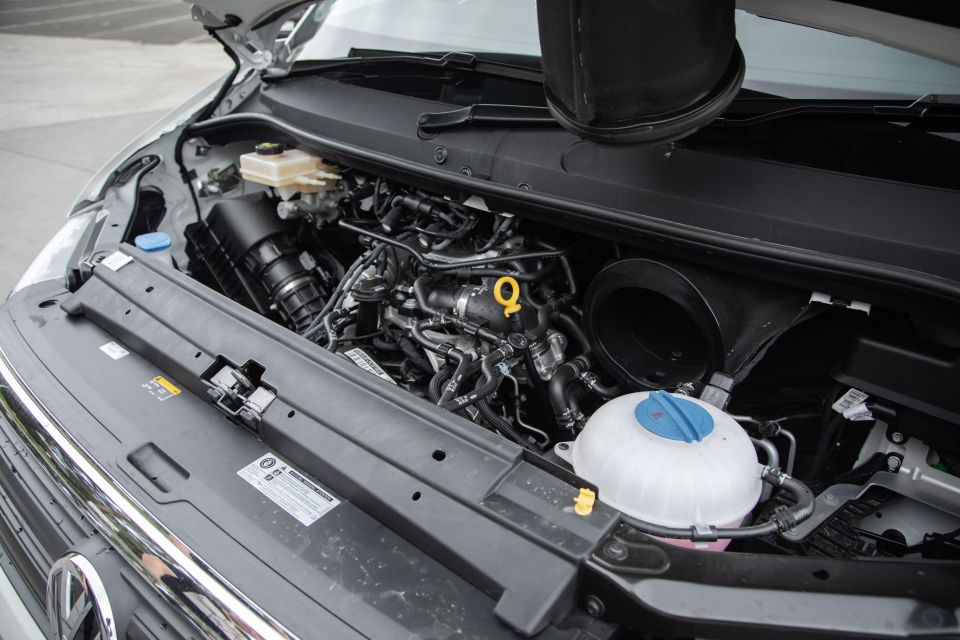
Though the Crafter cab chassis is available in front drive and transverse-oriented all-wheel drive, you really need the RWD – with its longitudinal engine – to facilitate the sort of muscle offered here, with our tester offering up to 2.0 tonnes of payload capacity and up to 3500kg of braked towing. (Volkswagen advertises as much as a 3378-kilo payload rating for the 55 cab chassis… not accounting for the weight of a fitted tray).
Of the two 2.0-litre turbo-diesels on offer, the 50 here uses the more powerful TDI410 bi-turbo version that produces 130kW at 3600rpm and 410Nm at 2000rpm. The lower-output TDI340 single-turbo unit favoured in the front-drive layout makes 103kW and – you guessed it – 340Nm.
The engine is backed by an eight-speed conventional automatic with an ‘electronic diff lock’ function to aid traction from its four 205mm rear tyres. Power steering is electric and all RWD Crafter get four-wheel disc brakes with slightly larger rear discs (303mm all round) than the front and all-paw versions.
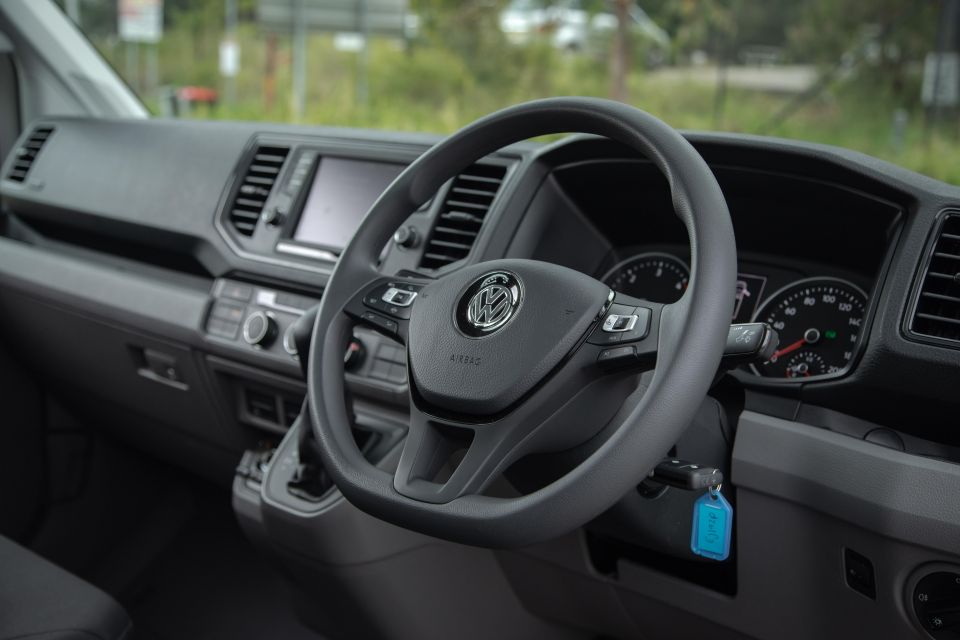
As you might expect, the turning circle for the LWB version is, at 16.2 metres, humongous and quite a bit wider than the more compact 13.6m of the (shortest) medium-wheelbase Crafters.
Because of the sheer variety of spec on offer in the Crafter ‘toolbox’ there’s no factory claim for combined consumption, but the best we saw on test was an impressive 10.2 litres through to low 12s depending on how it was driven (unladen).
That’s sure to climb relative to how much you’re lugging and towing with this vehicle that carries a GVM rating of a bit over seven tonnes (7077kg). The fuel tank capacity is 75 litres.
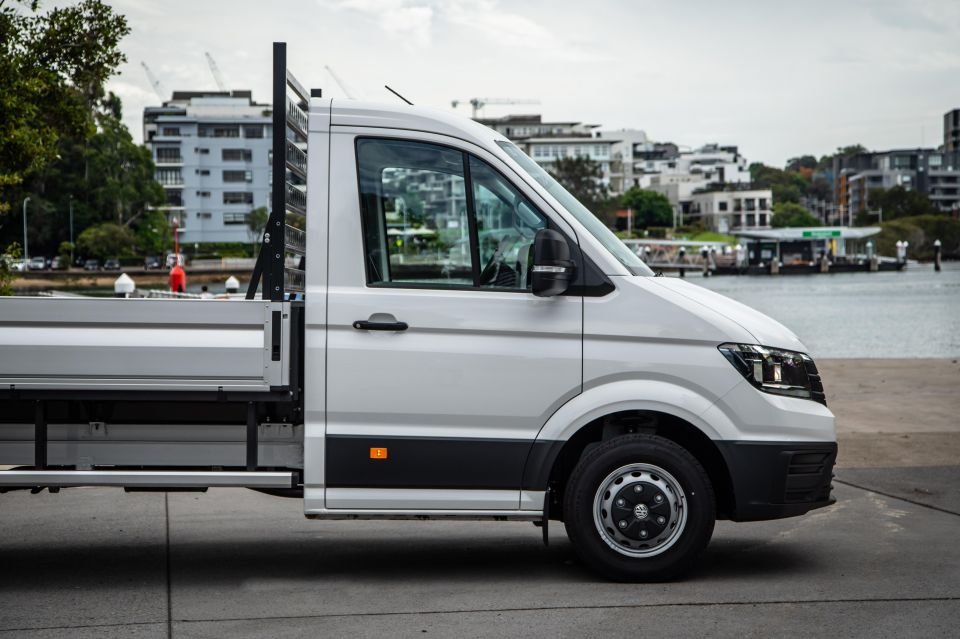
At 7004mm, the LWB doesn’t fit in most car spaces. And at 2319mm high – even without our tester’s fitted ladder rack partition – you really need to be mindful of which covered carparks you dare venture into.
But all in all, the Crafter is a surprisingly easy device to slip through even some of Sydney narrower confines. Sure, it’s still 2427mm between the tips of its wing mirrors, but if you’re cautious around other large road-going vehicles the Crafter slips like Teflon along in most lane width, meaning you’re not forever stuck behind slower-moving traffic when you need to get somewhere in a hurry.
Outward visibility is excellent and it’s an easy rig to judge in tighter spaces but you do need to be mindful of the sheer (4490mm) wheelbase of the thing, as it’s really easy to pick up roundabouts (turning right) and nudge street corner kerbs (turning left) with those dual rear wheels. Or worse, scrape something solid with the tray walls.
As mentioned prior, the fitment of an aftermarket reversing camera is not only a godsend, I’d consider it downright essential and something worth budgeting for. The view through the rear glass is obscured enough and the tray tail is high enough that reversing without it is a lot of risky and potentially expensive guesswork.
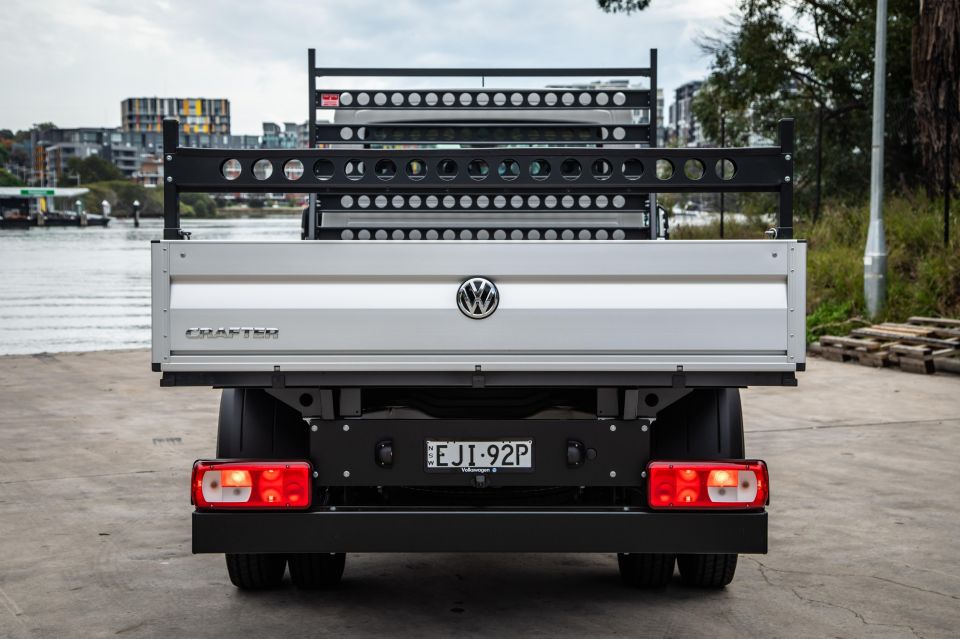
The powertrain is quite decent, with ample torque is quite a narrow sweet spot between the 2000rpm torque peak and the engine turning asthmatic beyond 3500rpm. It’s a rare excursion where the auto is utilizing all eight forward ratios frequently. That said, the Crafter doesn’t feel overly stressed – at least unladen – and climbs into higher ratios swiftly and effortlessly, providing a fairly refined and sedate powertrain experience.
Perhaps the real highlight is the steering. It’s direct, moderately weighted and utterly user-friendly. It really is an easy rig to pilot even in tight backstreets.
The downside – if arguably merely an inherent trait of the breed – is the terse ride quality, particularly unladen. What the heavy-duty suspension gives in terms of workhorse capability it takes away in the directly related ride comfort and bump control.
It’s not terrible by any measure, but across anything other than billiard-smooth surfaces the rigid vertical movement is downright relentless. I’d be interested to sample the regular suspension to see how much more compliant that tuning might potentially be.
Despite this, it’s easy to acclimatise to the LWB Crafter’s size and it really is quite an easy machine to punt from A to B…providing you can find a large enough place to park it once you get there.
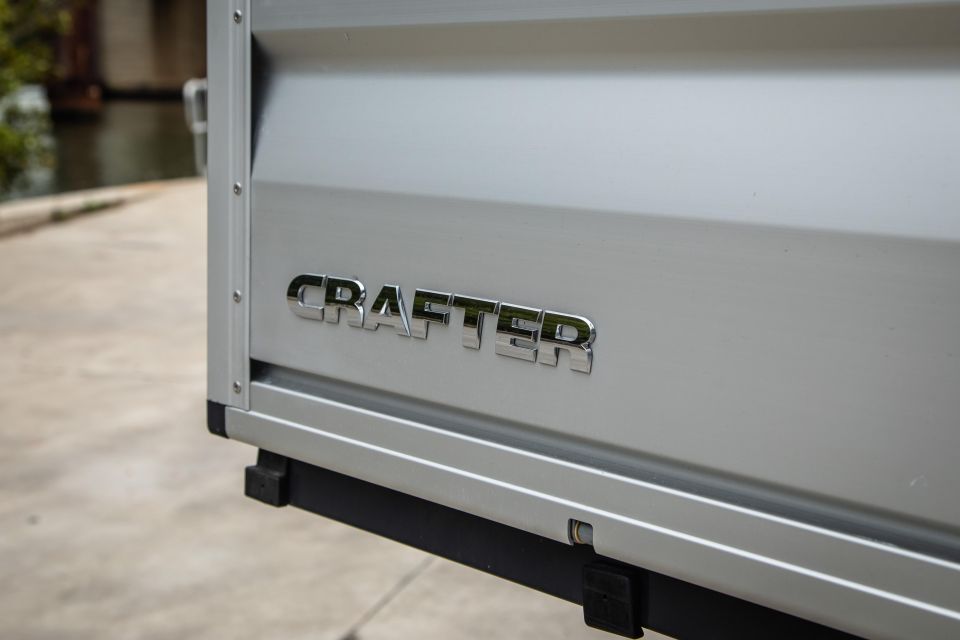
Where expert car reviews meet expert car buying – CarExpert gives you trusted advice, personalised service and real savings on your next new car.
Volkswagen covers the Crafter with a five-year, unlimited-kilometre warranty running with a year of roadside assist.
Servicing is at 12-month or 20,000km intervals, whichever comes first, with Volkswagen offering pre-payable three-year ($1450) and five-year ($2300) plans offering significant savings over paying for individual services as you go. The five-year plan includes a free first service.
That’s quite a bit more affordable compared with some competitor plans.

Buy your new car without the stress. It's fast, simple and completely free.

Great service from Travis and team, second time I have used this business would not hesitate to recommend them to anyone
Craig C.
Purchased a Ford Ranger in Sunshine Coast, QLD
CarExpert helped Craig save $7,224 on his Ford Ranger, now let us save you on your next new car.
Get your BEST priceDig through the options and there seems to be a Crafter fit for any want or requirement but our particular LWB rear-driven tray-back version presents itself as a compelling choice for maximum ability in a package that legal and user-friendly enough for those inexperienced with driving a serious truck.
If its sheer lugging ability is overkill for some buyer needs, it’s easy enough to scale down in the range, where 4Motion all-paw versions start to become quite desirable for users wanting all-terrain flexibility within a four-tonne GVM cap.
Likeable, usable, friendly and downright cheap to run, the Crafter really should sit on your shortlist when shopping for a properly capable tray-back.

Click the images for the full gallery
Where expert car reviews meet expert car buying – CarExpert gives you trusted advice, personalised service and real savings on your next new car.


Alborz Fallah
3 Hours Ago


Marton Pettendy
5 Hours Ago
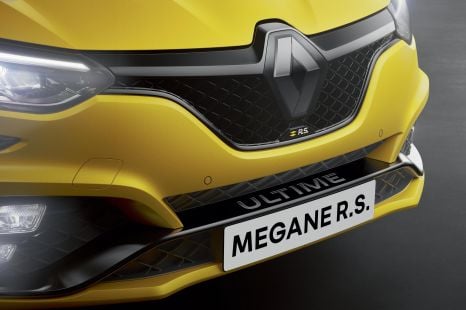

Ben Zachariah
7 Hours Ago


Damion Smy
7 Hours Ago


Damion Smy
9 Hours Ago
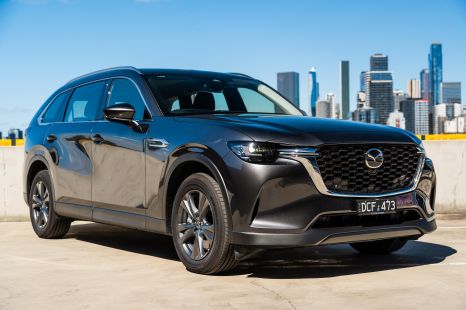

William Stopford
9 Hours Ago